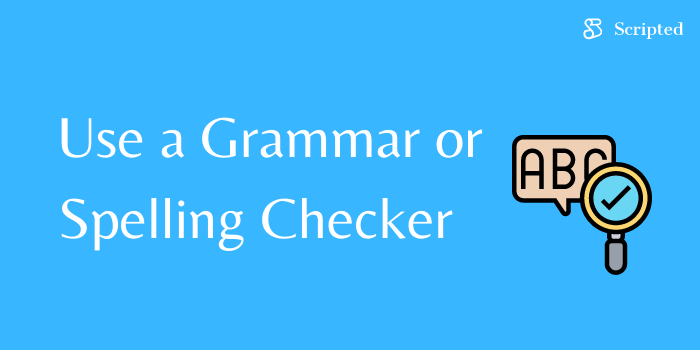- Blog Home
- Jubilee Heutmaker
- How To Deliver High Quality Content: A Step By Step Guide For Scripted Writers
How to Deliver High Quality Content: A Step-by-Step Guide for Scripted Writers

In freelancing and contract writing, a great deal of attention is placed on how to find a job, including where to look, what to say, how to pitch, and every other imaginable slant. But what do you do once you’ve landed a job on Scripted and you need to start writing? Even if you’ve been a writer for years, each client may have specific requirements and expectations, so it’s always a good idea to start fresh, work through the process, and develop a relationship with each client as if it was your first.
Here are some writer tips that should get you started. You may have more questions as you continue working with specific clients, but you typically can check in with the client to get further details and input as those needs arise. They are also essentials to consider as you continue working with Scripted clients. So, where should you start?
Review the Content Brief and Style Guide
Even if you have an idea of what the job is about, you should still review the project details again. It’s amazing how easy it is to let the details for various jobs blur together. Make sure you understand what you’re writing about, including the length and specific steps or approaches, and make a mental note about the level of research you’ll need to do for the job.
Explore the Client’s Site
If you’ve written about the topic for years, it might seem pretty basic, but you do need to review the client’s site, look at the tone and content of their posts and content, review their images, and carefully take note if there’s content related to the topic you’re covering. In many cases, you’ll need to link to the content on the client’s site. But, even if you aren’t being asked to link to content, you should still have a clear sense of how your work will relate to other content already posted live on their site.
Start the Job
Sometimes, the client may include an outline or rough idea of the content they want you to include in the article, but that’s not always the case. You should still draw up a rough outline and start filling it out with details, based on your professional knowledge and your credible research sources. When you start well before the deadline, you also have time to check in with the client and ask questions without worrying about being late with your delivery. Before you ask the client for clarification, read and re-read the Content Brief and Style Guide. If there are attachments or website links, read them too. Be sure that you're aware and have worked to understand what the client needs.
Cite Your Sources
Avoid using sources that are competitors to the client you’re writing for, even if they don’t specifically ask you to. Take special care to track and acknowledge internal and external sources for your work. Always provide the sources for statistics, but also check every source to be sure they are current (statistics more than five years old are often outdated), relevant, and credible. In most cases, you'll use inline links, where you'll link a word or phrase directly to the website or online document. The client might require a different citation method, though. If you're not sure, ask right away.
Use Active Voice
Let me say that again: USE ACTIVE VOICE. How you write is as important as what you write. You must write with authority in your work for clients because it's the best way to engage with your audience. Active voice makes your words more readable and persuasive, which will (hopefully) go a long way toward compelling the reader to take action. As a reminder, Scripted uses and encourages the use of AP style unless the client requests something different. If you don't have an AP stylebook handy, you can get a refresher at Purdue Writing Lab or other University Online Writing Centers. The main goal here is to be as clear, concise, and accurate with your writing as possible.
Anticipate and Deliver What the Client Needs
Based on your exploration of the client’s website as well as the Content Brief, you probably have a good sense of what the client is looking for. They may have let you know the tone and point of view, but even if they don’t include all the details for the stylistic approach, you can determine those details by taking another look at their website. Be sure to take note of any keywords they’ve asked you to include in your draft, as well as any links or reference material that you must include.
Find the Perfect Imagery
Most Scripted clients will request one or more images with the job. You’ve already had a chance to review the imagery on their website, and you may also review the graphics and photos they use in their social media posts. Based on those rough ideas and your own good graphic sense, you can quickly and easily track down graphics that should meet their needs. Never assume, however, that you have the right to use any image on the internet. Here are a few free image repositories that you should use.
Pexels: This site offers free photo and video downloads related to a myriad of topics both in the U.S. and around the world. Just search based on the topic you’re writing about, and you’ll often get plenty of options for download. You can select a single image or pick a couple that might offer a different perspective on the same topic or idea.
Pixabay: Pixabay boasts an astounding 2.3 million+ high-quality stock images, videos, and music clips. It’s often easy to find what you’re looking for, and you may actually see some crossover here (i.e., you’ll find Pixabay images on Pexels). If you don’t find what you’re looking for on one website, keep looking.
Unsplash: This site features beautiful, free images and photos that you can use for any project. It also has clearly defined featured categories for Back to School, Nature, Experimental, People, etc., so you can easily navigate to some options that may work for your topic. Otherwise, you can still use the search engine to find other usable imagery.
Flickr: While Flickr offers more options for permissions and copyright, it’s also essential that you only select photos that are identified as public domain photos. In some cases, particularly for some topics, you may need to at least consider whether the public domain photos on Flickr will meet the needs of your clients.
Of course, you may already have a favorite portal or site for free graphics. That works too. Make sure the site offers public domain imagery. There are plenty of great free photo and graphics sites. You should typically avoid offering photo recommendations that involve a fee or cost unless the client requests that you use a specific fee-based site for your photo selection. Even if you embed a photo as part of your writing copy, you should still provide the URL to make it easier for the editor and writer to find and assess the graphic or photo.
Be sure to find images that align with the look and feel that the client seems to prefer on their website. For example, if you see lots of young people in the photos on their website, search for imagery that will align with what appears to be that target market. You may also get a sense about those demographics when you review the Content Brief.
Use a Grammar or Spelling Checker
Even if you’ve read through your article, blog post, or other content several times, it’s still possible to miss a word here or there. Your grammar may be off in a sentence now and then, even if it sounds right. That’s why it’s always wise to run any writing through a grammar and spelling checker. You’re probably familiar with some of the big ones. They include Grammarly, White Smoke, Hemingway Editor, Slick Write, and Ginger Software.
You should also pay attention to the red or blue underlined words in your Scripted interface as you write. Re-read your work to determine what's wrong with the sentence, so you can correct it. Even the best writers in the world use grammar and spelling checkers to make absolutely certain that their writing is as great as it can be, so it’s important that you take the time and effort to make sure that you don’t miss anything before you submit the article or other content for review.
Paste the Final Copy into the Scripted Form
Some writers do all their writing via Microsoft Word or Google Docs and then paste the final copy into the Scripted template. Other writers simply do all their writing in the form. Either way, you can make use of the online tools to check your writing.
Your goal with these online resources is to perfect your writing so that you will deliver a quality product that the client will be happy to include on their website, social media posts, or other sites across the internet. Even if it looks perfect, the first time you read through it, you should still take another look. Read it several times and make sure that you’ve said everything in the best way possible.
Once you’re confident that the content is as solid as it can be in the time you have allotted and you’ve taken into consideration the recommendations of other online tools and resources, the next step is to paste the final content back into the form. Make sure all the formatting is correct. Read it through again to make sure that you didn’t miss anything.





